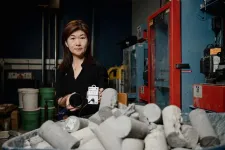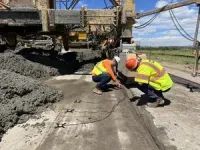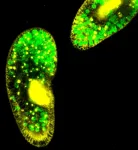(Press-News.org) WEST LAFAYETTE, Ind. — A Purdue University invention that may shorten construction timelines and increase long-term durability of concrete highways, bridges and other transportation infrastructure is emerging as a viable alternative to methods that have been used for decades to estimate when newly poured concrete is mature enough to withstand heavy loads such as those from trucks and other vehicles.
The American Association of State Highway and Transportation Officials’ Committee on Materials and Pavements (AASHTO COMP) has approved the Purdue-developed method as a new national standard. AASHTO membership is comprised of the departments of transportation (DOT) of all 50 states, the District of Columbia and Puerto Rico. The creation of this standard, published Wednesday (July 31), puts the method on a path for states and contractors to consider looking into it as a new practice.
Embedded directly into fresh concrete, the Purdue invention uses sensor technology to provide engineers with relatively precise and consistent real-time data on concrete’s strength, which may be comparable or even surpass the accuracy of several current tools and methods.
For highways and bridges, less uncertainty associated with determining when concrete pavement is strong enough to handle heavy truck traffic can potentially allow newly repaired road sections to open sooner, which could save money spent on those repairs and increase convenience for the traveling public.
In the long term, a more precise determination of strength gain of the concrete over time can also help pavements last longer by not loading them too soon and inducing early damage or fatigue, affecting durability.
Opening roads sooner to traffic after construction and improving their condition could also result in financial savings for the commerce sector by reducing delays for the transportation of goods and services and leading to less wear and tear of long-haul freight trucks.
“The majority of our infrastructure was built in the 1950s and 1960s. At that time, the population in the U.S. was only half of the current population,” said Luna Lu, Purdue’s Reilly Professor in the Lyles School of Civil Engineering, who invented the sensor technology. “This means that all this infrastructure was not built and designed for the volume of traffic, the frequency of use and the amount of people we have today. We have to think of a better way to communicate with our infrastructure.”
Working with states on a promising new idea
Concrete pavement makes up less than 2% of U.S. roads but approximately 20% of the U.S. interstate system, which supports much of the nation’s traffic.
As part of a Federal Highway Administration pooled-fund study, Purdue researchers and Wavelogix, a startup Lu founded in 2021, have been testing the invention as a commercial beta product in these states: Indiana, Iowa, Kansas, North Dakota, Missouri, Tennessee, Louisiana, Texas, Colorado, Utah and California. Rui He, a PhD student in Purdue’s Lyles School of Civil and Construction Engineering, has led the team’s work in completing more than 20 tests over the past year, installing the sensors into highways, bridge decks and retaining walls.
Initial results from testing in these states indicate that the sensor technology is potentially more accurate and consistent than some of the existing concrete strength tests which are considered to be “state-of-the-practice.” The Purdue-Wavelogix team also has plans to test in other states. However, creating awareness of this new AASHTO standard is a crucial step toward DOTs officially adopting this method into their state construction and materials testing specifications.
As awareness grows, more state DOTs will likely experiment with the new method to validate and attain their own experience and expertise. If during this process state DOTs conclude this new method is viable, they will gradually implement its use through specifications for construction project contracts. Whether the new AASHTO standard gains traction in the field leading to widespread acceptance will not likely be known for several years to come as innovation and change generally happen gradually in the construction industry.
The Indiana Department of Transportation (INDOT), which has funded the sensor technology since the beginning of its development, proposed the method as a standard to AASHTO COMP’s technical subcommittee on hardened concrete last summer, as the Purdue invention was starting to become a commercial product.
“There have been wins all along in the lab and with the technology,” said Mike Nelson, a concrete engineer in INDOT’s Division of Materials and Tests, who has worked with Lu and her team throughout the entire process of establishing this technology as a new concrete strength test.
This process has included a handful of tests in several Indiana highways and bridges to develop the model that Wavelogix launched to market in December as a commercial product called the REBEL concrete strength sensing system. Wavelogix licenses the technology from the Purdue Innovates Office of Technology Commercialization, which has applied for patent protection on the intellectual property.
INDOT is currently conducting its own verification tests of the REBEL product and has added this technique to its Indiana Test Methods Index, which will allow the technology to be used in Indiana once it is validated by field trials and pilot projects.
“The implications of this technology are staggering because everybody who pours concrete — it doesn’t matter whether you’re building a skyscraper or a road — what you want to know is the strength of the concrete so you can move on with construction. There’s nothing anywhere else in the world that can determine concrete strength in place like this does,” Nelson said.
Daniel Tobias, a member of AASHTO COMP’s technical subcommittee on hardened concrete and the engineer of concrete, soils and metals for the Illinois Department of Transportation, also saw the value of this method and assisted with the drafting of the standard based on INDOT’s proposal. In November, DOT representatives in the subcommittee and the parent Committee on Materials and Pavements voted to advance this standard to publication.
“The committee agreed that the idea and the research had worth based upon the introduction of the work from Indiana and its sponsors, and so we decided to try to move it forward,” Tobias said. “If we can get a reasonably good estimate of concrete strength quickly, that gives us a faster answer about when we can open the road or the bridge to traffic. We’re always looking for new ways to do that. This was a novel application that was developed from scratch that nobody had seen before.”
Challenging the status quo in concrete strength testing
Lu and her lab started developing this technology in 2017, when INDOT requested help in more accurately determining when pavement is ready to be opened to traffic.
The most common method that the industry has used for decades calls for testing large samples or “cylinders” of hardened concrete at a lab or on-site facility. Using that data, engineers estimate the strength level that a particular concrete mix will achieve after being poured and left to cure at a construction site. Although these tests are well understood by the industry, discrepancies between lab and outdoor conditions can result in inaccurate strength estimates due to the different cement compositions, the temperature of the surrounding area and other factors.
Another less frequently used method for determining strength is known as the maturity concept, which uses a recently established time and temperature history of a particular concrete to develop a maturity-strength curve. Measurement of the heat given off over time during the chemical reaction of cement with water provides a reasonable estimate of strength gain over time, but this method is very specific to a particular mix used at a particular time and place.
“You might think that it’s super straightforward to measure the strength of concrete, but it’s not as exact of a science as you might think it is,” Tobias said.
With the technology Lu and her team invented, engineers no longer have to rely on concrete sample cylinders or the maturity concept to estimate when fresh concrete has cured enough. Instead, they can more directly monitor the fresh concrete and accurately measure its strength and temperature.
Construction workers install the sensors by securing them to reinforcement or placing them on the subgrade, a layer of soil that provides the foundation for paving concrete. After pouring the concrete, they plug each sensor cable extending from the concrete’s formwork into a reusable handheld device that automatically starts logging data. Using the app, workers can receive information on real-time growth in the concrete strength for as long as the strength data is required.
“Every time I’ve handed a sensor to a contractor, the only question they’ve asked me is ‘When will this be available?’ The value added to the industry is so apparent to the people who would be using this technology on a day-to-day basis,” Lu said.
Lu’s lab invented this sensor technology based on its discovery that vibrations in concrete could be used to detect rigidity and other mechanical properties that convey the concrete’s strength. This technology uses electrical energy to excite the sensors, which vibrates the concrete, and then converts the mechanical energy of these vibrations back to electrical energy. The sensors measure the change in the frequencies of the vibrations of the concrete over time and correlate this change to concrete strength gain.
A mathematical model that Lu’s lab developed to describe this physical phenomenon and later create the software for the REBEL product was awarded the Alfred Noble Prize from the American Society of Civil Engineers in 2022. “This was an indication from the scientific perspective that people see this as a very important discovery,” Lu said.
The technology has received numerous other accolades over the course of its development. In April the REBEL product was recognized as a gold winner of an Edison Award in the category of Critical Human Infrastructure. The innovation has appeared on Time’s Best Inventions of 2023 list and Fast Company’s Next Big Things in Tech for 2022, and it was named a “Gamechanger” on the American Society of Civil Engineers’ 2021 Report Card for America’s Infrastructure.
The process of turning this invention into a commercial product has also been supported by multiple awards from the National Science Foundation. Wavelogix recently received a $3 million investment from Rhapsody Venture Partners and has secured support from a group of angel investors.
Lu is optimistic about the technology’s future and the benefits it will bring to concrete infrastructure throughout the U.S.
“What has me really excited is getting the industry’s feedback and seeing a matching of the technology to a problem,” Lu said. “Invention is when you develop something, but when this something solves a bigger problem, that is innovation.”
END
States consider new science-backed solution to save time and money on concrete infrastructure repair
2024-08-01
ELSE PRESS RELEASES FROM THIS DATE:
New England Journal of Medicine letter shows plant protein beats animal protein
2024-08-01
BOSTON—Plant-based proteins have major health advantages over animal-based proteins, according to a New England Journal of Medicine letter to the editor by Neal D. Barnard, MD, published Aug. 1, 2024. New findings show that all plants contain all essential amino acids, in contrast to the common but mistaken belief that plants lack one or more amino acids. Of the 20 amino acids that are the building blocks of protein, nine cannot be produced by the human body. All are found in plant sources.
“In addition, plant-based ...
August issues of APA journals cover new research on PTSD, suicide, personal recovery, eating disorders, and more
2024-08-01
WASHINGTON, D.C., Aug. 1, 2024 — The latest issues of three American Psychiatric Association journals, The American Journal of Psychiatry, Psychiatric Services, and Focus are now available online.
The August issue of The American Journal of Psychiatry brings together research on PTSD, phobias, suicide attempts, and psychiatric vulnerabilities. Highlights include:
Neurobiology and Treatment of Posttraumatic Stress Disorder.
Testing Quantitative and Qualitative Sex Effects in a National Swedish Twin-Sibling Study of Posttraumatic Stress Disorder.
Sexual Identity Continuity and Change in a U.S. National Probability Sample of Sexual Minority Adults: Associations ...
Angel Martí elected fellow of the American Chemical Society
2024-08-01
By Jade Boyd
Special to Rice News
Rice University’s Angel Martí has been elected a fellow of the American Chemical Society (ACS), one of his discipline’s highest honors.
Martí, professor and department chair of chemistry, is among 37 newly elected fellows announced by ACS this week. With more than 200,000 members in 140 countries, ACS is one of the largest scientific organizations. Fewer than 1% of its members are fellows, a distinction reserved for those with exemplary records of both service to the society and outstanding scientific or professional achievement.
Martí joined ...
Rice, DOE labs tackle knowledge gap in materials science research
2024-08-01
HOUSTON – (August 1, 2024) – Materials behave differently in different size regimes, and researchers tend to cluster their efforts either at the nanoscale, examining materials in atom-level detail, or at the microscale, looking at structures between three and five orders of magnitude greater.
However, less is known about what happens in the “in-between” realm spanning from 10 billionths to 1 millionth of a meter.
“We call this the mesoscale,” said Rice University materials scientist Lane Martin, who together with collaborators at the U.S. Department of Energy’s (DOE) Argonne National Laboratory and Lawrence Berkeley National ...
ACM publishes first issue of Proceedings of the ACM on Software Engineering
2024-08-01
ACM, the Association for Computing Machinery, has recently published the first issue of Proceedings of the ACM on Software Engineering (PACSME), a new Gold Open Access journal publishing top-quality, original research on all aspects of software engineering, from requirements elicitation to quality assessment, design, maintenance, evolution, and deployment. PACMSE covers a broad range of topics and methods that help conceive, create, and maintain better software be it embedded, cloud-based, mobile and ubiquitous, or runs on conventional computers.
“The overarching goal of the new PACSME journal is to make ...
Barriers complicate exercise for disability community
2024-08-01
An estimated 16% of people worldwide live with a significant disability that impacts their daily life. Of this population, only about 40% engage in aerobic activity. Due to this lack of exercise, people with disabilities (PWD) are more likely to suffer from chronic conditions such as heart disease, stroke, diabetes, or cancer and are at higher risk of mental illnesses like depression and anxiety.
“Many PWD struggle with psychological issues such as low self-esteem and negative body image, which can further reduce their motivation to participate in exercise activities, especially in public places ...
Venezuelan crisis has negatively affected country’s Internet
2024-08-01
As the Venezuelan crisis intensifies, researchers and policy experts have worked to understand its ramifications on the country’s politics, economics, health services, water security, infrastructure and more.
Now, Northwestern University computer scientists have comprehensively examined the effects of the crisis on a previously unexplored area: the Internet.
In a new study, the researchers found the crisis has significantly — and negatively — affected Venezuela’s Internet infrastructure and connectivity. Compared to the ...
COSPAR 2024: Embracing team spirit in space research
2024-08-01
The Committee on Space Research (COSPAR) has successfully concluded its 45th COSPAR Scientific Assembly in Busan, Korea, held from 13 to 21 July. This prestigious event brought together more than 3,000 experts and leaders from 55 countries in all major fields of space science, under the theme “Team Spirit in Space Research”. This biennial event, actively supported by major space organizations, is a benchmark for fostering dialogue and collaboration within the global space science community.
Bringing space leaders together
Of particular note this time was the showcasing of ...
'Cowpuppy' takes readers into secret world of cows
2024-08-01
During the height of the COVID-19 pandemic Gregory Berns, a neuroscientist at Emory University, moved from Atlanta to a farm an hour south of the city. His reinvention from city dweller to farmer led to his upcoming book “Cowpuppy: An Unexpected friendship and a Scientist’s Journey into the Secret World of Cows.”
Set for publication by Harper Collins on August 20, the book describes Berns’ crash course to becoming a cattleman and his ongoing fascination with the interior world of cows.
Berns originally bought a few cows to keep the grass in the ...
Warming stops tiny organisms working together
2024-08-01
Hotter conditions prevent two tiny organisms working together for mutual benefit, new research shows.
University of Exeter scientists studied a single-celled organism (Paramecium bursaria) which can absorb and host algae (Chlorella spp).
This pairing is common in freshwater worldwide, and their symbiotic relationship provides benefits including trading of nutrients and protection for the algae.
But when scientists made the water 5°C warmer, the partnership stopped working – and the results suggest the algae may even become parasitic.
The breakdown of such relationships could have a major impact on ecosystems.
“This ...








